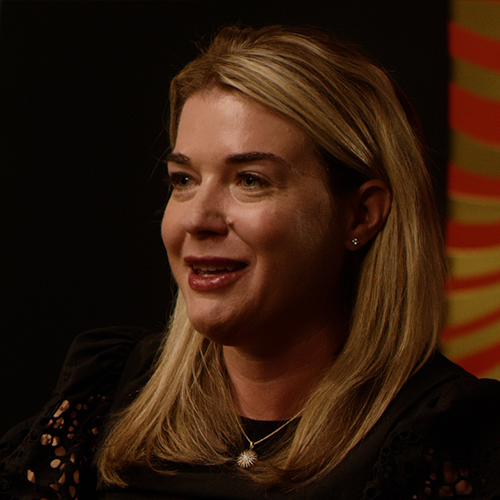Wunderkind Presents: The CMO State of the Union
- 0.5
- 1
- 1.25
- 1.5
- 1.75
- 2
Richard Jones, Wunderkind: The golden age of marketing, perfect pitches.
Speaker 2: And that is why it was just with the oysters.
Richard Jones, Wunderkind: Three course martini lunches. Iconic ad slogans.
Speaker 3: Ugh, forgot my AmEx.
Speaker 2: I told you, don't leave home without it.
Richard Jones, Wunderkind: Modern day marketers might feel their roles have little in common with our marketing forbears. The massive proliferation of social media, the ubiquity of mobile and huge e- commerce growth, sparked a constant battle for consumers' attention and fundamentally changed what it means to be a marketer. The world has transformed beyond recognition over the past two years, and with it, marketers have been forced to throw out they're outdated playbooks and reassess their priorities. Marketing teams around the world are scrambling to keep up with near constant changes in consumer behaviors, technology, and market economics. As part of the Wunderkind CMO State of the Union research study, we surveyed over 100 marketing leaders to get their perspective on the current state of marketing. The data revealed that when faced with trials and roadblocks, CMOs began to shine. We firmly believe that the challenges we've all faced over the last several years have compelled marketers to ditch the status quo and go back to the proverbial drawing board. Today, we're going to explore the key takeaways from the research outlined in the Wunderkind CMO State of the Union white paper, and talk about why marketers need to rethink how they approach their marketing strategies and tech stacks. What worked yesterday, won't work today so marketers need to find new ways to drive sustained growth. Our study highlighted that many CMOs were able to negotiate temporary budget increases to drive revenue and brand awareness, especially online. 79% of CMOs have shifted more of their marketing spend online, but only 29% feel this shift will actually last, and nearly 71% are already planning to reduce their online marketing spend in the future. As consumers feel the pinch from inflation and brick and mortar bounces back, marketing leaders might need to pivot once again.
Joe Anhalt, Koio: It's funny, I feel like Koio has been through a lot of different phases of the journey. Obviously every startup does. And most recently, I feel like we've really gone back to the drawing board as it relates to how we think about brand and creative. We used to be much more dedicated to these big photo shoots and video shoots and spending a lot of marketing dollars and just capital in general on producing this. And because of the pandemic, obviously cutting costs and things of that nature, we're taking much more of a kind of hacker hustle mentality and looking to other brands in the market and understanding how they're producing content.
Shawn Patel, JLO Beauty : Yeah. A hundred percent. I think, A, you should be going back to the whiteboard every month and seeing where you want and what needs to be changed. I think creative is such a big piece that a lot of people miss, where it's like, how do you constantly fuel everything that you're doing with new creative?
T.R. Wilhoit, Case-Mate: I think the biggest thing the last few years is, as e- commerce matures and you have both older and younger generations using e- commerce and buying from Amazon or from your. com, they have different needs and how do you meet both of their needs in different ways? Gen Z doesn't want to be sold anything. It's got to be cool. So how do you make it cool? It's like, you don't try to make it cool, you make good stuff and you make it look good, and that's how you start.
Richard Jones, Wunderkind: Marketers have to be prepared to turn the traffic and interactions they are driving online into a sustainable source of revenue. CMOs need to find ways to maintain digital revenue, even if their online marketing spend has been cut. It's not easy, but if your budget has been cut, you can't afford to waste dollars on traffic that won't convert. In many ways, the hardship might be a good thing because it encourages marketers to rethink the status quo and push the boundaries of what is possible. Another factor that comes into play here is the loss of third party cookies. Lower budgets combined with a lack of attribution will require CMOs to go back to the drawing board and come up with new ideas. Maybe one of those martinis might help. Thank you. Let's dig deeper into what the Wunderkind CMO State of the Union study tells us all about the end of third party cookies. 60% of CMOs feel prepared for cookie deprecation, but 40% feel there's more work to be done. We all know the end of third party cookies is a reality we have to face very soon. There's no way around it. Firefox and Safari have already stopped tracking cookies on their browsers years ago, and Google is not that far behind. Our research shows that while the majority of CMOs are preparing for the loss of third party cookies, they haven't figured out how to turn it into a competitive advantage. Where do marketers stand on the loss of third party cookies and how are they preparing for the impact on the marketing industry in general?
Jordan Roberson, Johnny Was: Well, it's certainly annoying as a marketer, right? CPMs are way up year over year. Again, it just goes back to incrementality testing though, and just literally looking at data and saying, " Is this working or not working?" Constantly testing new audiences. And then for me, I need to diversify my media mix. That's probably one of the number one things. Different platforms are going to have different sets of first party data that they have available.
Sarah Pierson, Margaux: I'm probably a contrarian in saying this, but I actually am happy that we're struggling to attribute in some ways, because I think that it's really forced us to focus on what is truly organic and what is truly paid, and figuring out how you triangulate that. And so really being diligent on the platform level, but then also making sure that we're staying on track from a kind of full picture perspective with acquisition and cost of acquisition.
Rahul Chand, AAA Northeast: The richer and better our first-party data is, the less we have to rely on cookies to be able to support our digital marketing efforts. So we've explored other social networks that may be smaller, but more relevant, and really kind of inject ourselves in meaningful, relevant conversations where it makes sense rather than just mass market on Facebook and not necessarily reach the right audience there.
Amanda Bopp, Kate Spade: We are big believers in first-party data and we have amassed a significant amount of first-party data, and we treat that data with the utmost respect. So personally, for the work that I do day in and day out, the deprecation of the cookie is not a huge challenge for us to overcome. I think the constant thing that we are thinking about is, how do we make the communications and messaging that we are sending to, those customers that we have first party data for, how do we make it as relevant as possible? So for me, that's really the important thing versus thinking about what to do about the cookies. It's, how am I treating the customers that have raised their hand and said, " Please communicate with me." How am I making sure that the messages and the product that I'm putting in front of them is really going to make a difference for them and is going to be relevant and personal?
Richard Jones, Wunderkind: As most brands have been relying on third party cookies for so long to target and engage with existing and potential customers, marketers will now need to find unique ways to acquire new customers and drive revenue. First party data is a new performance channel most marketers aren't aware they can tap into. In our survey, marketers rank first party data as having the least positive impact on marketing results, as legacy SaaS systems can only identify up to 5% of website visitors. But with a performance growth marketing platform that is centered around first party data, marketers are able to identify more of their traffic to unlock a new scalable revenue channel. Building a one- to- one messaging strategy will be key to driving engagement, and ultimately revenue. Now let's talk about how 78% of CMOs believe they have a good customer experience strategy that creates meaningful one- to- one interactions between their company and its consumers. Yet, consumers say otherwise. Well, that's awkward, isn't it? Most CMOs feel they're delivering class leading experiences, yet consumer feedback clearly reveals customer frustrations. The CMOs in our study even admit they aren't very good at recommending products based on consumer interest. And when shoppers aren't happy with how brands communicate with them, they flock to Amazon to make their purchasing decisions easier. So what's going on here? Where are brands falling short?
Joe Anhalt, Koio: I think it's a few things. One, everyone thinks their baby is beautiful, but it's not. And also I think customer expectations have gone through the roof and it's really challenging to match them because, no matter if you're a startup, mid- size, mature company, you're still competing with the likes of Amazon and these supply chain just behemoths.
T.R. Wilhoit, Case-Mate: Some of it's red tape. I mean, when you're at a bigger corporation, there's not enough paid attention to an individual customer. Everything's in aggregate. So when everything's in aggregate, you have no idea what the feedback really is, you're getting it filtered through eight different channels. So I think it's really important, I think, for CMOs, for marketing teams in general, no matter the company's size, to really get the voice of the customer in some ways and get real feedback from a customer. I mean, honestly, the best thing a CMO could do is get into customer service for a few hours a month and see what in the world people are asking about.
Rahul Chand, AAA Northeast: When I think about a brand perception, it's really not what you think your brand is, it's really what the consumer is telling what your brand is. We could talk about us being a fun brand, but if we're not perceived as a fun brand, we're not a fun brand because the consumer gets the final word on this. So I do think there is that disconnect, right? I find that oftentimes marketers are usually comparing themselves to the wrong comparison set. They're either comparing their performance today to their performance from last year, or they're comparing their performance to others in that comparison set.
Amanda Bopp, Kate Spade: I think that sometimes brands have a tendency to focus on functional needs. We are business people and so we think that we need to get all of those functional things correctly, right? Like the handbag has to have the zipper in the right space and the pocket in the right space, and if we do this, we'll sell more units and et cetera, et cetera. And focusing on those functional needs, those are all good things and those are the right things to do. I think sometimes we lose the balance and we forget about the emotional needs. Our consumers are human beings. They have a lot of things going on in their lives. And I think it's wonderful if the functional needs can support their lives, I think we have opportunity to think more deeply about how our brands and our brand values can help to support the emotional aspects of their lives.
Richard Jones, Wunderkind: There is a disconnect between consumers and brands, which stems from the fact that marketers can't recognize a customer for who they are and where they are. We know this because CMOs ranked first party data as the least impactful marketing metric in the study. Only 40% of CMOs say first party data has a positive impact. Social media scored higher with 59% of marketers claiming to see a positive impact. This shows that the majority of marketers are still overly reliant on external channels and third party data to target, retarget, and acquire new customers. This is a problem. These aren't owned channels. You can't influence them. And the cost of advertising is skyrocketing, but it's even more problematic when we look at what that means for the customer experience. What customers truly desire is individualized brand interactions, but without a handle on your own data and channels, it becomes incredibly difficult to scale one to one messages and offer customers the customized experiences and tailored communication they expect. The final part of the Wunderkind study looks at marketing technology and how they fit together. Marketing and technology go hand in glove, and they always have. The 1960s to 1990s saw a happy marriage between advertising and technology as marketers leveraged the new mass medium of television. Fast forward to now, legacy SaaS and technical debt are significantly holding CMOs back from being able to move forward with their marketing objectives. Marketing leaders are drowning in a sea of data and technology that isn't connected or talking to each other. Just 1% of company leaders believe their company is extremely mature when it comes to technology, and depressingly, only 9% of company leaders believe their tech strategy greatly enables their marketing performance. Even companies that grew up as leaders in e- commerce face the challenge of outdated technology. How important is the synergy between tech and marketing?
Shawn Patel, JLO Beauty : I think it's twofold, right? I think you do have to build the right team that can handle all the SaaS that you're bringing in, legacy SaaS, new SaaS, whatever it is. If you don't have the right team in place to do it, the right person in place to manage the SaaS, then you're going to fail. I don't think necessarily you have to build it all in house though. I think that there's a plethora of services and vendors and companies out there now, and platforms, that can give you best in class, but you also have to have somebody in house that can manage the best in class.
Amanda Bopp, Kate Spade: Yes and no. There are a variety of different SaaS providers that we work with. What I will say is that they suck up a lot of dollars on the P and L. And I think it's an important exercise from time to time to go through and to evaluate what all of those partners are and what the unique value they provide is into that customer experience.
Jordan Roberson, Johnny Was: I would just say that we're kind of a scrappy team. If something doesn't work, we're going to end up cutting it and we're find a new partner. We're not going to just stick with some type of a legacy system that doesn't work for us.
Sarah Pierson, Margaux: Maybe the advantage of being frugal is that we have no legacy SaaS to really work with, and so what that has allowed us to do is really only invest in a tool or a software when we believe in it and we haven't been married to tools that might otherwise hold us back. In some ways that means that we've taken a very lean and mean and maybe sometimes basic approach, but in other ways it means that we've really been able to be patient in terms of what partners we choose to work with and how.
Richard Jones, Wunderkind: At Wunderkind we believe there is a strong need to improve the synergy between marketing technology and marketing outcomes. Legacy SaaS technology is expected to drive revenue, but often it just soaks up revenue. CMOs then believe the only solution is to hire analysts and investing consulting services to make sense of all their customer data and interactions, which can take a lot of time and money. We need to stop looking at legacy SaaS and human resources as the only way to unlock first party data as a growth strategy. Instead, marketers should explore providers who offer a revenue first approach powered by identification technology that can scale marketing messages that drive revenue. Let's face it, marketers spend a huge amount of money driving traffic to their sites, 95% of which they can't identify and don't convert. And that site traffic costs increasingly large amounts of money to drive. Wunderkind can helps identify and convert far more of that traffic, building your marketing lists in the process. If you can achieve return on advertising spend efficiencies in a recession, you'll be cutting your CFO a lucky break Right now is a challenging yet exciting time for marketers, and we could even be headed to a new golden age of marketing as the challengers push us all to level up how we interact with our customers. With budget changes and cookie deprecation, marketers will need to bring their A game and come up with new creative ideas to compensate and make up for lost revenue. The gap between how marketers see their brand communications and how consumers actually feel about them shows that businesses urgently need to take charge of their own data and channels. Customers expect and demand to be treated as the holistic individuals that they are. The synergy between marketing and tech is absolutely essential. Data silos and tired legacy SaaS systems are holding marketers back, and this has to change. CMOs need to look outside the box to new performance growth channels, like Wunderkind, that will allow them to build a more efficient revenue machine that their finance team will love, instead of being exposed to spiraling customer acquisition costs in the midst of a recession and having to go cap in hand to the CFO. Thank you to our clients for offering their valuable insights, and thank you for watching.
DESCRIPTION
In this webinar, we explore why marketers must embrace a new era of marketing by rethinking how they approach their marketing mix and questioning legacy SaaS products that are holding them back. As marketing conditions continue to change, CMOs must find new ways to drive sustained growth.
What worked yesterday, won’t work today. But CMO’s are ready for the challenge.
Today's Guests

Shawn Patel

Rahul Chand

Sarah Pierson

Jordan Roberson

Amanda Bopp

Joe Anhalt

Richard Jones








